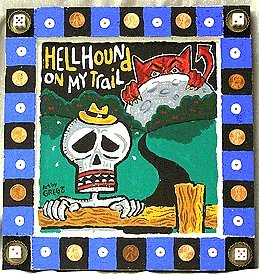THIS SERIES IS RETIRED. BOXES ALL MISSING !!!Background:
Hoodoo is an American term, originating in the 19th century or earlier, for African-American folk magic. Hoodoo consists of a large body of African folkloric practices and beliefs with a considerable admixture of American Indian botanical knowledge and European folklore. Although most of its adherents are black, contrary to popular opinion, it has always been practiced by both whites and blacks in America. Other regionally popular names for hoodoo in the black community include "conjuration," "conjure," "witchcraft," "rootwork," and "tricking." Hoodoo is NOT the same thing as Voodoo. Credits: Lucky Mojo website:
http://www.luckymojo.comThe Letterboxes and Stamps:
A lot of the practices and beliefs of Hoodoo were expressed in old Blues songs. The stamps in this series are based on some of these hoodoo influences on the Blues. The stamp images are based on the works of folk artist Grego (
http://www.artbygrego.com/).
First is the
Mojo Hand. This item, also known as a conjure hand, toby, trick bag, jomo, or nation sack, frequently takes the form of a flannel bag filled with roots, herbs, minerals, and other "curios." The mojo bag is usually carried on the person, but it can also be hidden in the bedroom or at a place of business, or placed behind a doorway. The word “mojo” is thought by some to be a corruption of the English word "magic" but it more likely is related to the West African word "mojuba," meaning a prayer of praise and homage. It is a "prayer in a bag"; a spell you can carry. Muddy Waters popularized the tune, “Got My Mojo Working.” You can listen to and watch a clip of Muddy working his Mojo at the Hoodoo Blues music website:
http://groups.myspace.com/hoodoobluesClue: If you want to get your Mo”joe” working, I would head to a place near the intersection of S. Clinton and S. Goodman that bears the name of this “Hootchie Cootchie Man.” The establishment is owned by Jake Kane, a musician in a local blues band called the “Mud Kings,” who has generously allowed this “joe”mo to be planted here. When you walk in, turn right, and you will see a tall bookshelf next to the bathroom. On the top shelf, you’ll see the box next to the book on American Roots Music. If you are feeling tired, you might order a “Howlin’ Wolf” to perk you up.
"Crossroads"
Next is the
Crossroads. The crossroads is the most popular place to perform a specific hoodoo crossroads ritual to learn a skill; to play a musical instrument, for instance, or to become proficient at throwing dice, dancing, public speaking, or whatever one chooses. As this ritual is usually described, you bring the item you wish to master (your banjo, guitar, fiddle, deck of cards, or dice) and wait at the crossroads on three or nine specified nights or mornings. On your last visit, a " big black man" will arrive. Some have called him the “devil”, though not usually the religious devil of which we usually think. He’s more like a teacher. If you are not afraid and do not run away, he will ask to borrow the item you wish to learn. He will show you the proper way to use the item by using it himself. When he returns it to you, you will suddenly have the gift of greatness. Robert Johnson, legendary blues musician, was fabled to have got his greatness from a crossroads ritual, and wrote “Cross Road Blues.” You can listen to “Cross Road Blues” at the Hoodoo Blues music website:
http://groups.myspace.com/hoodoobluesMISSING I THINK! Clue: A great place to hear some blues musicians, and eat some good New Orleans style grub, is at Beale Street Café. You’ll find the original location at the crossroads of South Ave. and Gregory St. But if you want to sell your soul to the Devil, you’ll have to cross the road to where you see a phone booth. You might find the Devil down a parking lot alley, but mark sure you turn right before you pass the "spiritual center." You will see a very old staircase painted in the Devil's colors, at the end of the alley on your left. You'll find “Crossroads” tucked up under the staircase platform at the top of back pillar.
[Extra Credit: If you want to check out a store who caters to those who practice Santeria (a religion with some similar origins and practices as hoodoo) walk back up to South Ave., turn right and cross Gregory going north. On the right side you will find "Botanica Obatala Shango", ring the bell and you can enter.
Lastly is the significance of the
Lucky 7. The number can be attributed to lots of different sources including the seven days in the week, the seven visible planets, the seven seas, etc. Seven is significant in Masonic and biblical references. Blues songs of the era talk of the gifted “seventh son of a seventh son”. Most of the modern references refer to the lucky roll of the dice in the game of Craps. “The Seventh Son” blues classic by Willie Dixon talks about his gifted life as a lucky man. You can listen to and watch a clip of Willie at the Hoodoo Blues music website:
http://groups.myspace.com/hoodoobluesMISSING I THINK Clue: If you want to roll a Lucky 7, I suggest you find a “Good-man” and head on down to the Village Gate. Here you will find a record shop that specializes in Blues, Jazz, and American Roots music. They have 10,000 vinyl albums for sale, and the cheap ones they don’t even bother locking up in the store at night. They just leave them in the hallway. If you roll the dice right, you might roll a “Lucky 7” behind the last record rack nearest the exit sign.
